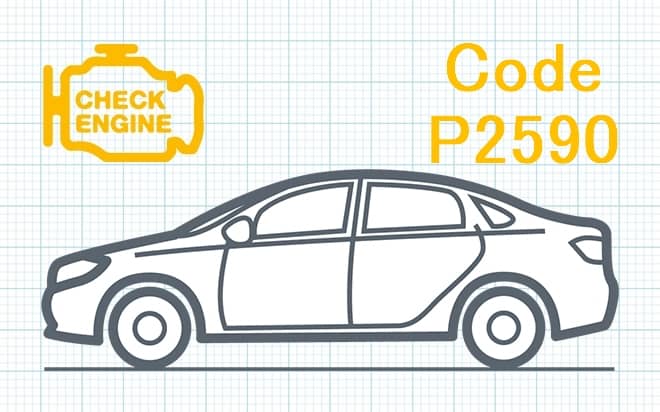
P2590 Turbo Boost Control Position Sensor B Unstable Circuit
Content
P2590 Turbo Boost Control Position Sensor B Unstable Circuit
Home »Codes P2500-P2599» P2590
OBD-II DTC Datasheet
Malfunction of a chain of the sensor of position of management of turbocharging "B"
What does this mean?
This Diagnostic Trouble Code (DTC) is a generic transmission code, which means it applies to OBD-II equipped vehicles with a turbocharger (Ford, GMC, Chevrolet, Hyundai, Dodge, Toyota, etc.). Although general in nature, the specific repair steps may differ depending on the brand / model.
This DTC usually applies to all OBDII equipped turbocharged engines, but is more common in some Hyundai and Kia vehicles. The turbocharger control position sensor (TBCPS) converts the turbocharging pressure into an electrical signal to the powertrain control module (PCM).
The Turbocharger Control Position Sensor (TBCPS) provides additional information about the turbo boost pressure to the transmission control module or PCM. This information is commonly used to fine tune the amount of boost the turbocharger delivers to the engine.
The boost pressure sensor provides the PCM with the rest of the information needed to calculate the boost pressure. Whenever there is an electrical problem with the TBCPS, depending on how the manufacturer wants to identify the problem, the PCM will set code P2590. This code is considered a circuit malfunction only.
It also checks the voltage signal from the TBCPS sensor to determine if it is correct when the engine is initially shut down. This code could be set due to mechanical (usually exhaust back pressure / admission restriction) or electrical (boost pressure sensor / boost control position sensor circuit).
Troubleshooting steps may vary depending on the manufacturer, sensor type, and wire colors to the sensor. Consult your specific vehicle repair manual to determine which sensor “B” your specific vehicle has.
Corresponding turbocharger position sensor "B" circuit codes:
- P2586 Turbocharger boost control position sensor "B"
- P2587 Turbocharger boost control position sensor "B" Circuit Range / Performance
- P2588 Turbocharger boost control position sensor "B" Low in the circuit
- P2589 Turbocharger boost control position sensor "B", high signal
symptoms
Symptoms of a P2590 code may include:
- Fault indicator light is on
- Low productivity
- Oscillations during acceleration
- Decreased fuel economy
reasons
Possible reasons for setting this code:
- An open in the signal circuit to the TBCPS sensor - most likely
- Short circuit on voltage in the signal circuit on the TBCPS sensor
- Short circuit on weight in the signal circuit of the TBCPS sensor
- Loss of power or ground at the TBCPS sensor - most likely
- Faulty TBCPS sensor - possible
- Failed PCM – Unlikely
Diagnostic and repair procedures
A good starting point is always to check the Technical Service Bulletins (TSB) for your particular vehicle. Your problem may be a known issue with a known manufacturer-released fix and could save you time and money while troubleshooting.
Then find the TBCPS sensor on your specific vehicle. This sensor is usually screwed or screwed directly onto the turbocharger housing. Once found, visually inspect the connector and wiring. Look for scratches, scuffs, exposed wires, burn marks, or molten plastic. Disconnect the connector and carefully inspect the terminals (metal parts) inside the connector. See if they look burnt or have a green tint indicating corrosion. If you need to clean the terminals, use an electrical contact cleaner and a plastic bristle brush. Allow to dry and apply electrical grease where the terminals touch.
If you have a scan tool, clear the DTCs from memory and see if P2590 returns. If this is not the case, then there is most likely a connection problem.
If the P2590 code does return, make sure you have good turbo pressure by checking it with a mechanical pressure gauge. Check the specifications of your vehicle manufacturer. If boost pressure does not pass, determine the root of the problem for the low boost pressure (possible exhaust restrictions, wastegate problem, faulty turbocharger, intake leaks, etc.), clear codes and recheck. If the P2590 is not present now, then the problem was mechanical.
If the P2590 code does return, we will need to test the TBCPS sensor and associated circuits. With the key OFF, disconnect the electrical connector at the TBCPS sensor. Connect the black lead from the DVM to the ground terminal on the harness connector of the TBCPS. Connect the red lead of the DVM to the power terminal on the harness connector of the TBCPS sensor. Turn on the engine, turn it off. Check manufacturer specifications; the voltmeter should read either 12 volts or 5 volts. If not, repair open in the power or ground wire or replace the PCM.
If the previous test passes, we will need to check the signal wire. Without removing the connector, move the red voltmeter wire from the power wire terminal to the signal wire terminal. The voltmeter should now read 5 volts. If not, repair open in signal wire or replace PCM.
If all previous tests pass and you continue to receive the P2590, it will most likely indicate a faulty TBCPS sensor, although the failed PCM cannot be ruled out until the TBCPS sensor is replaced. If you are unsure, seek help from a qualified automotive diagnostician. To install correctly, the PCM must be programmed or calibrated for the vehicle.
Related DTC discussions
- There are currently no related topics in our forums. Post a new topic on the forum now.
Need more help with your p2590 code?
If you still need help with DTC P2590, post a question in the comments below this article.
NOTE. This information is provided for informational purposes only. It is not intended to be used as a repair recommendation and we are not responsible for any action you take on any vehicle. All information on this site is protected by copyright.

